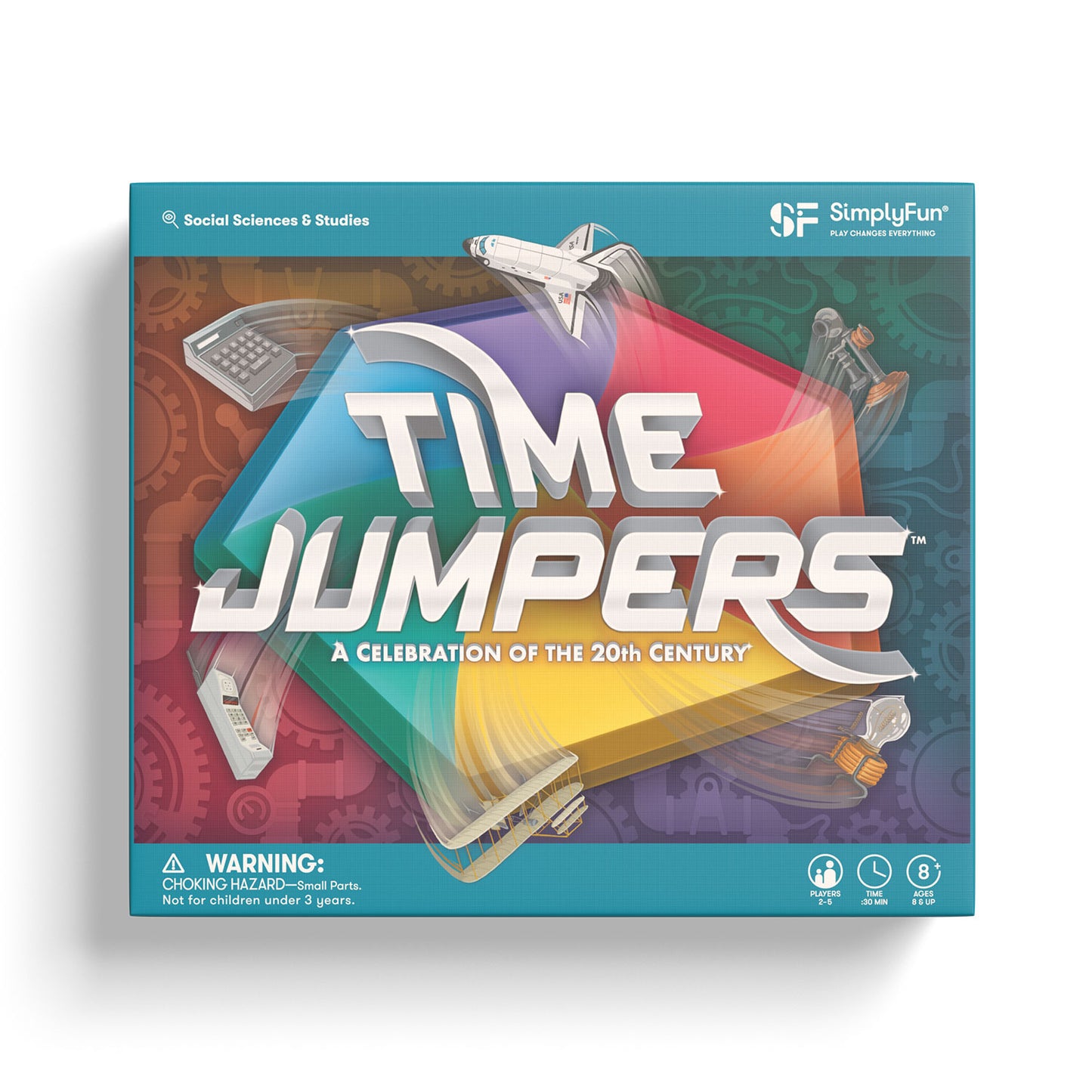
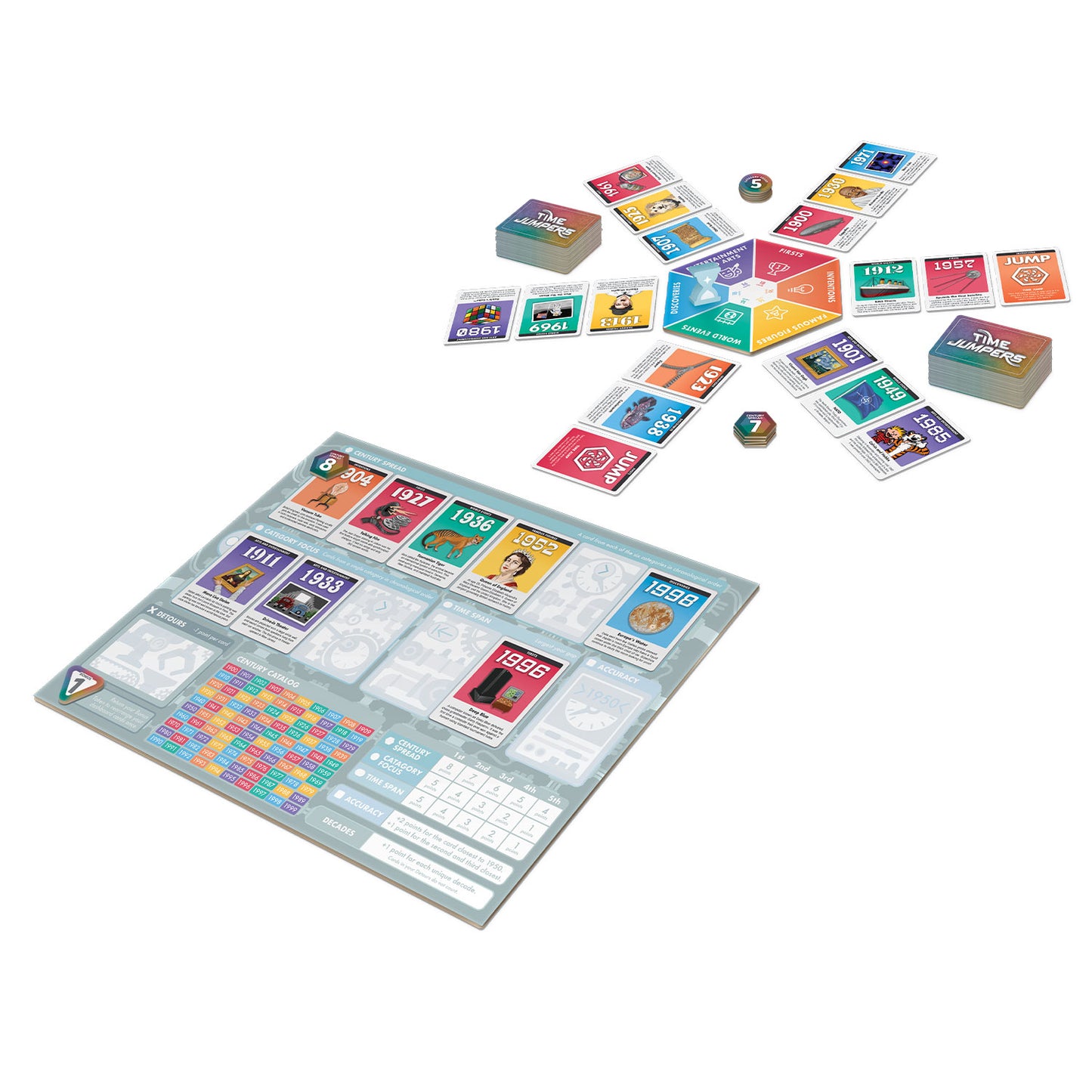
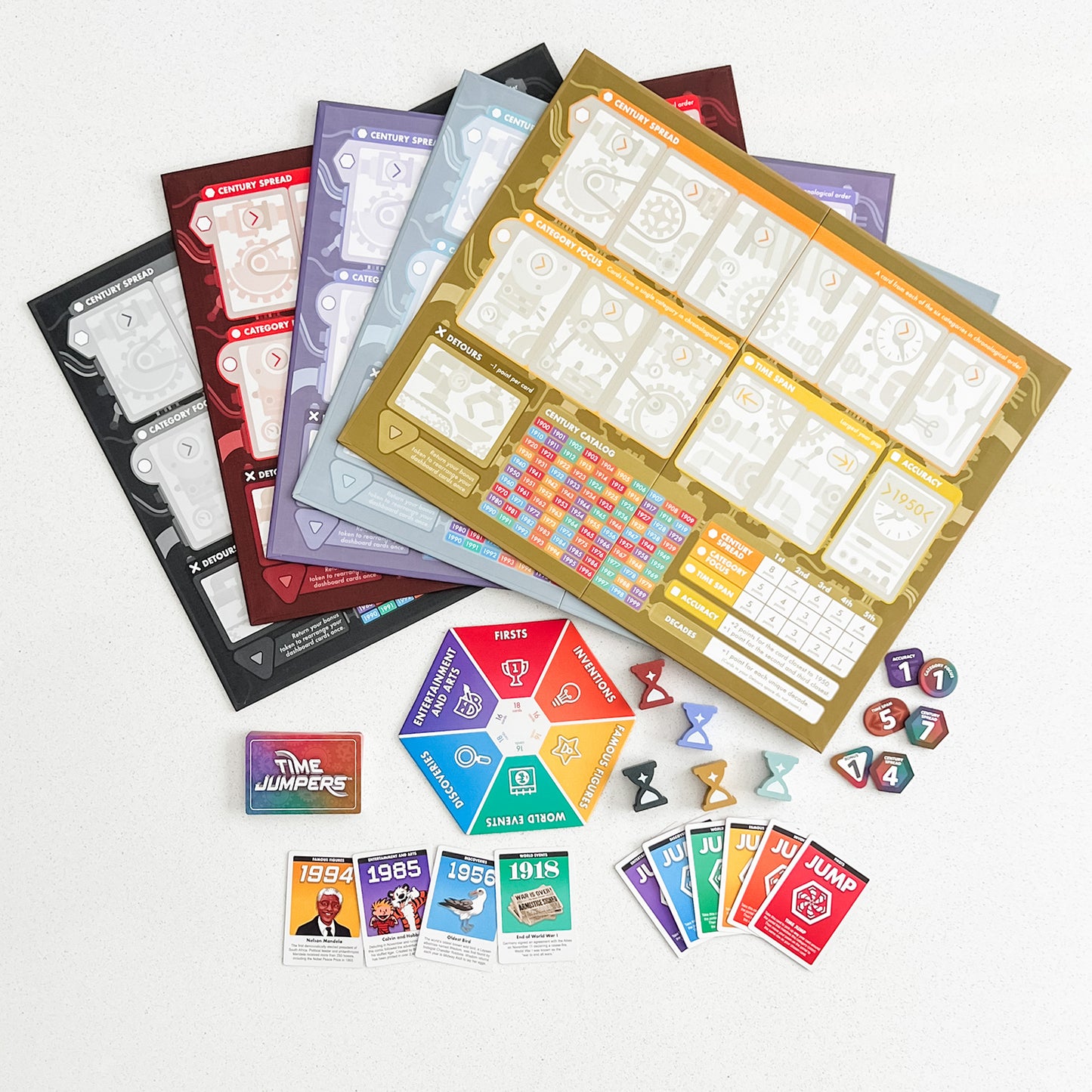
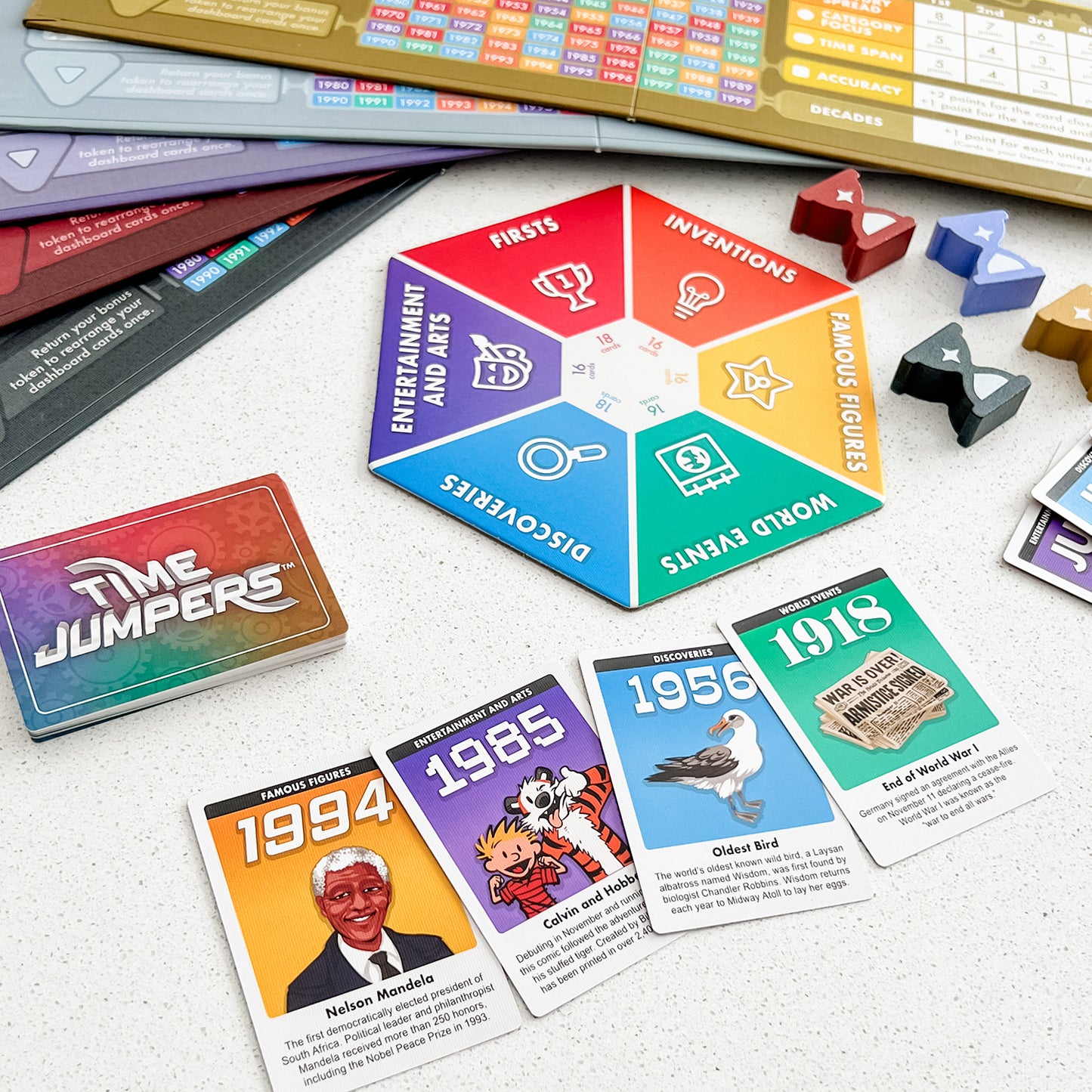
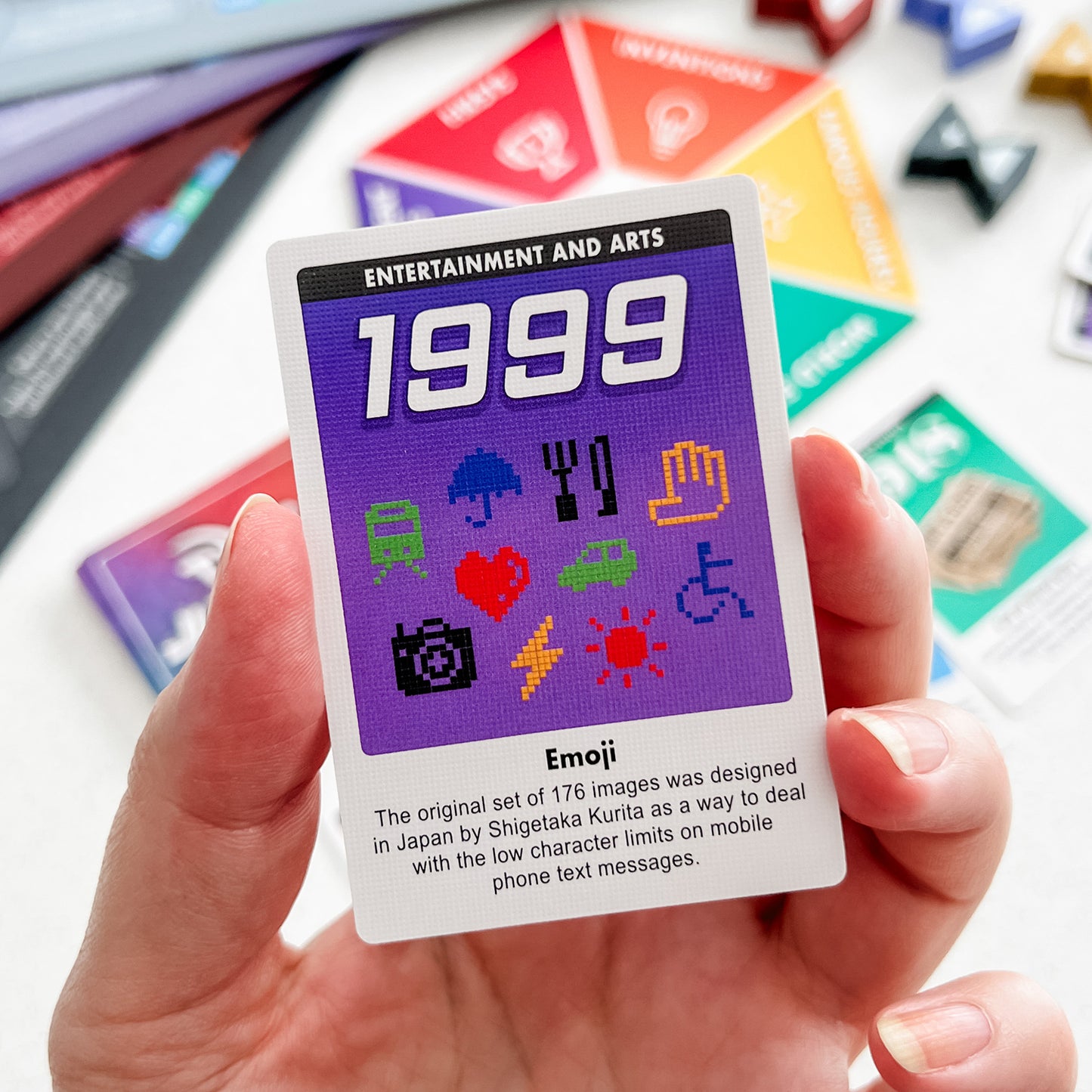
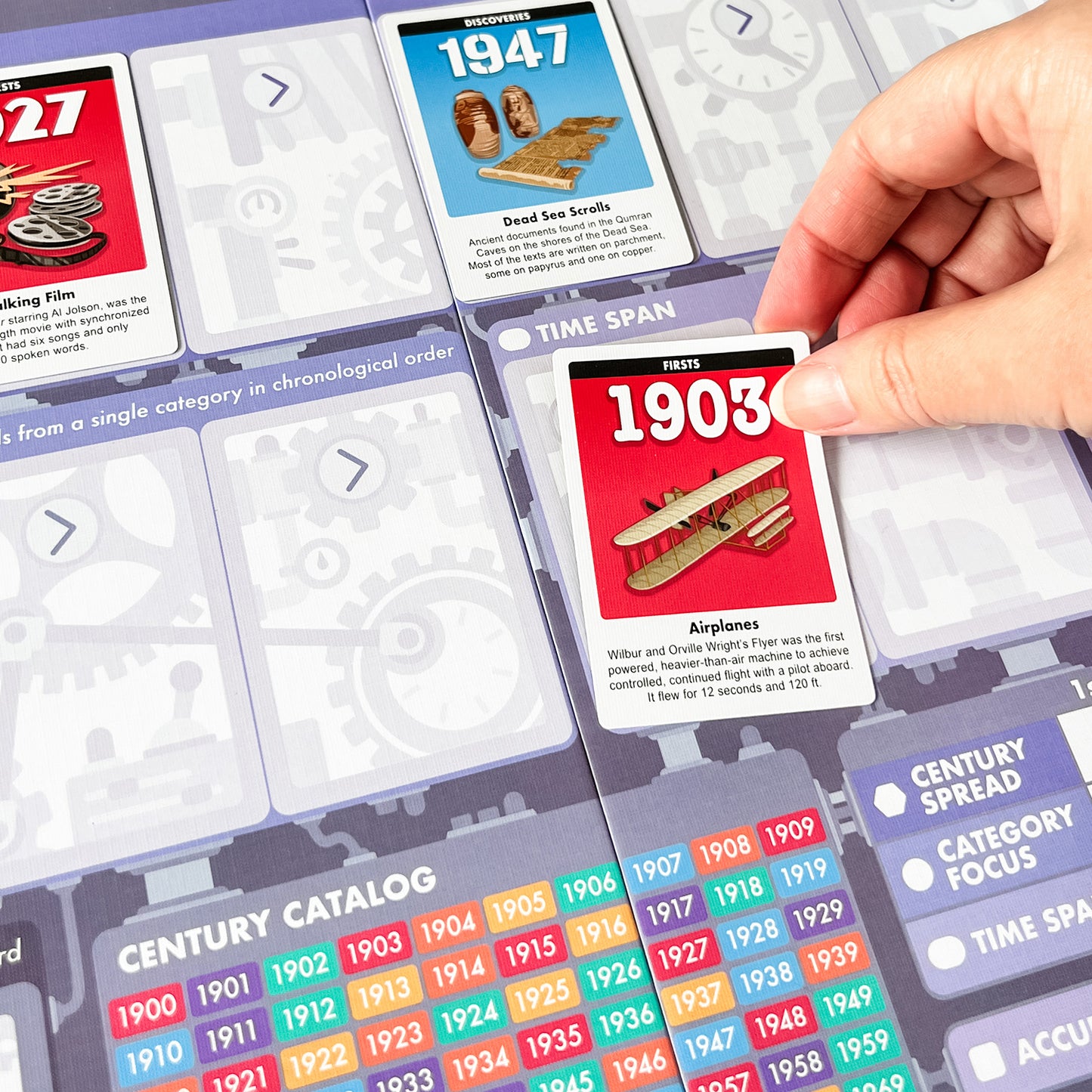
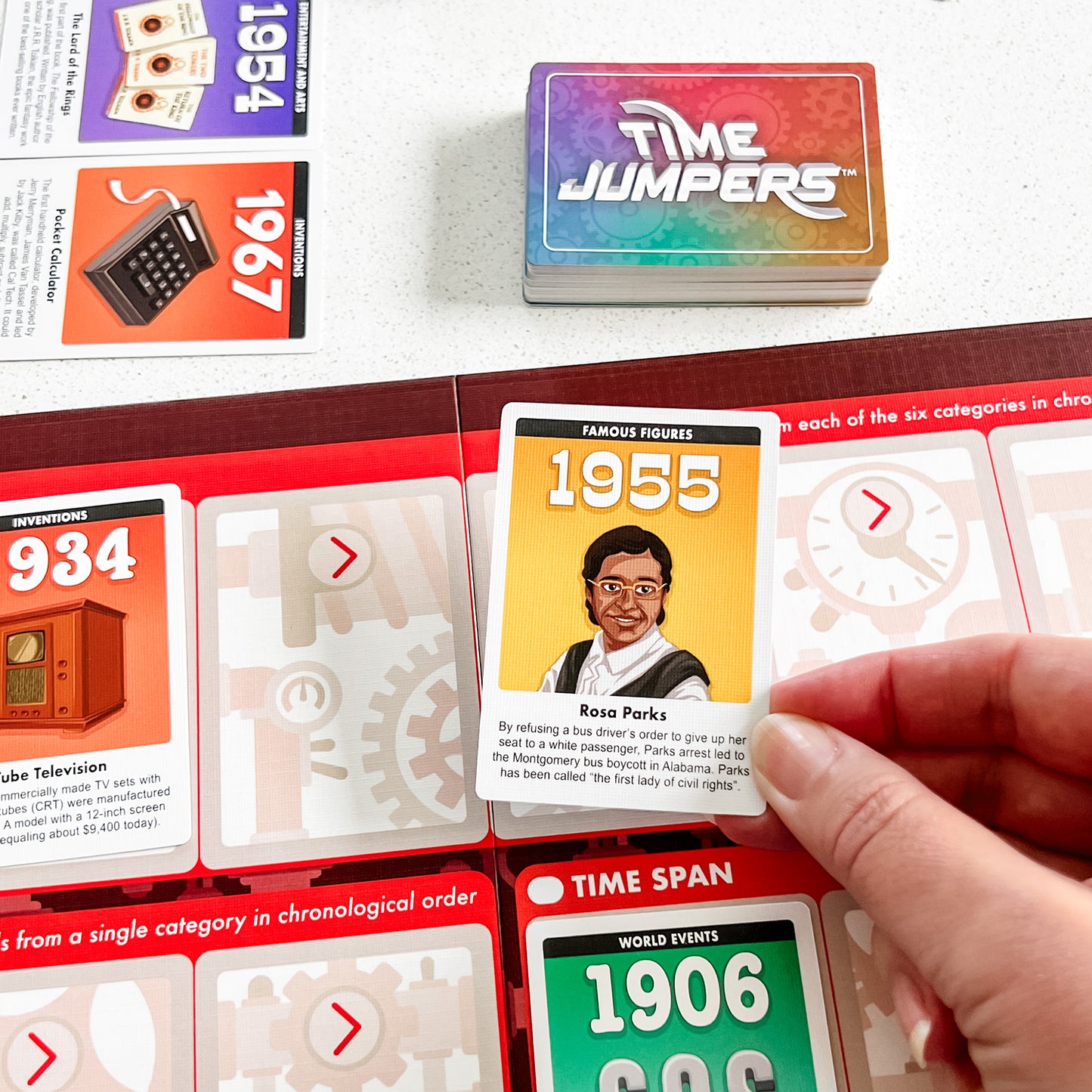
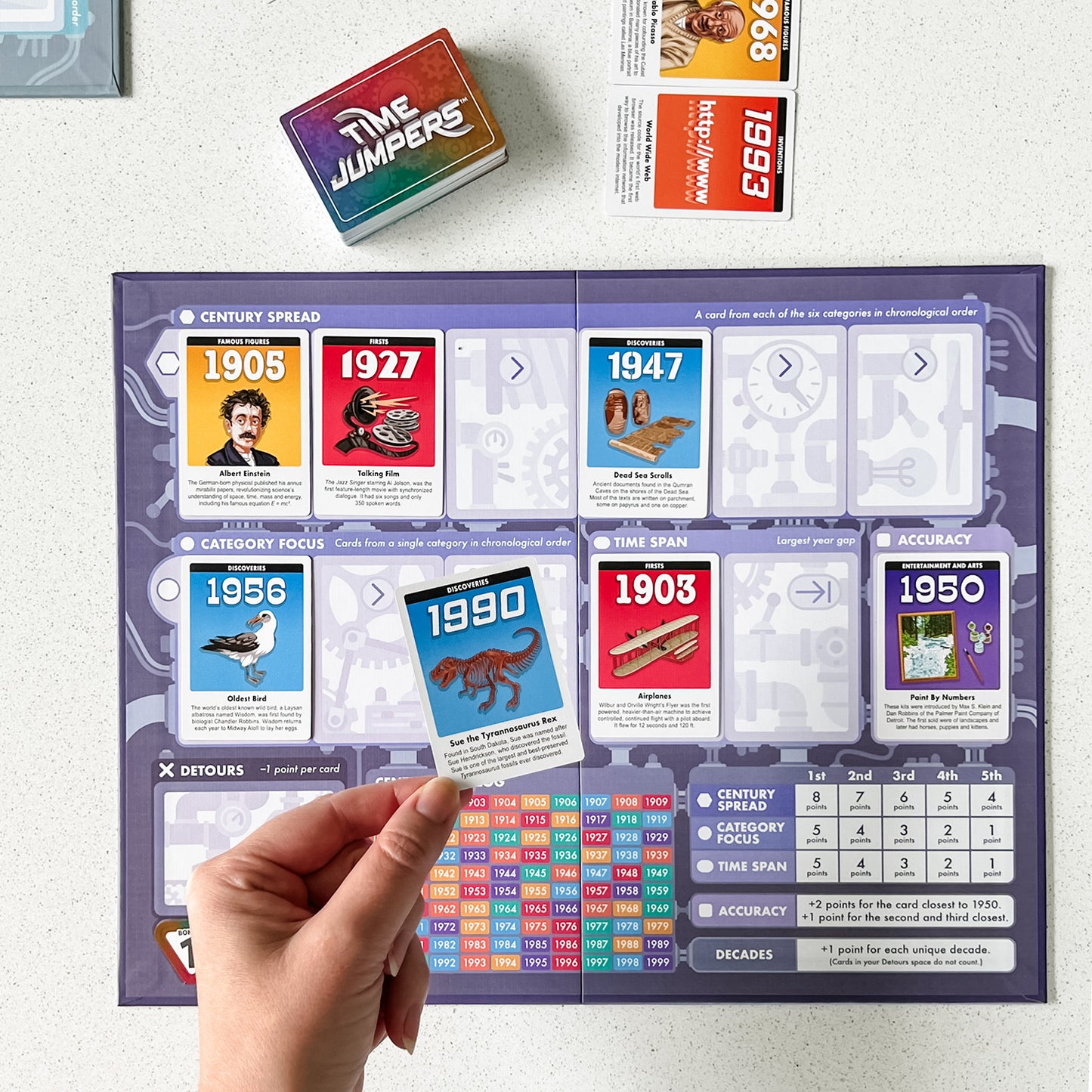
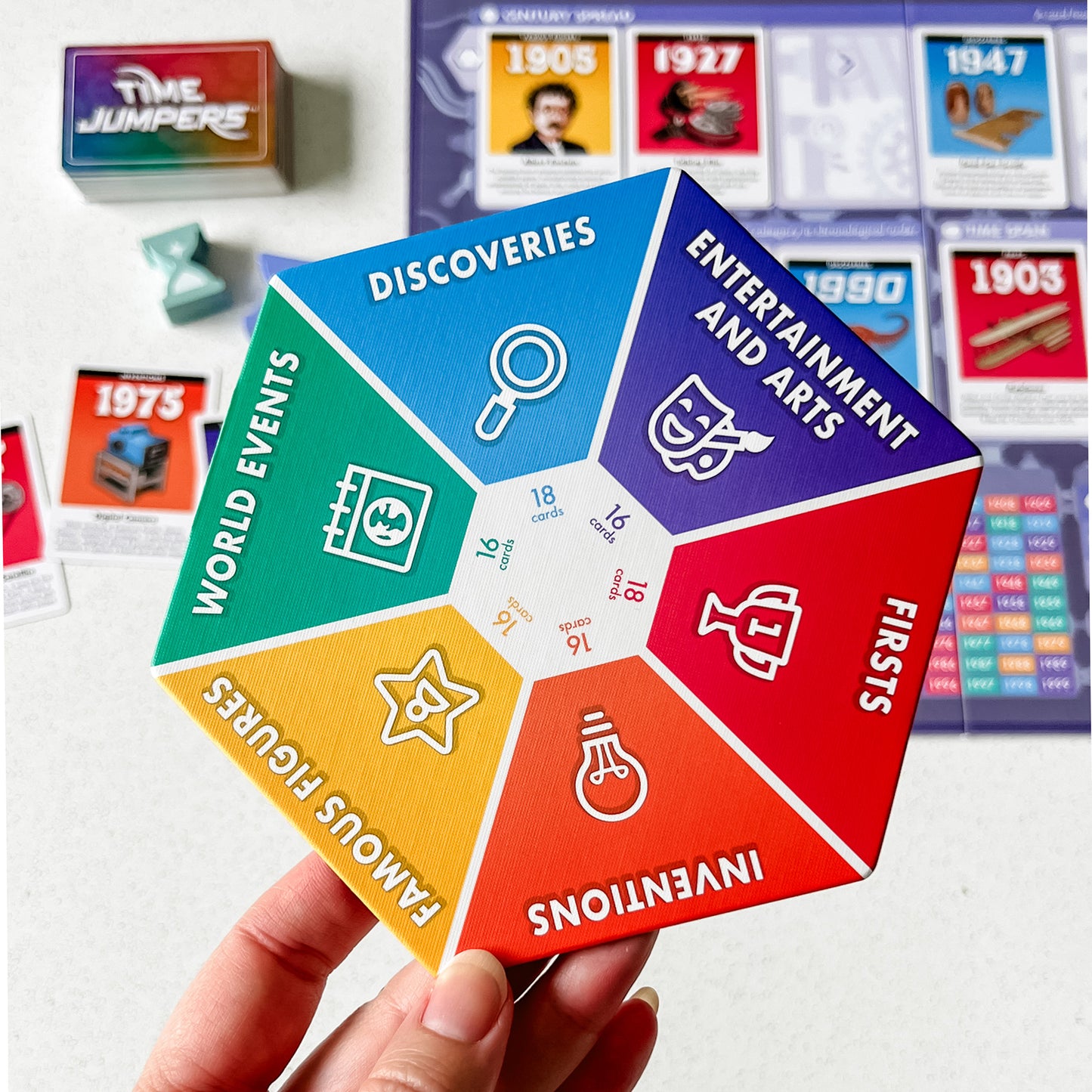




Players move around the category portal board and collect cards trying to place them in chronological order on their dashboards. Different point values are earned depending on how efficiently they complete their board. The player with the highest score at the end wins.
Collapsible content
A game where players travel through 100 years of history in a race to earn the most points.
You can play Time Jumpers with 2-5 players, ages 8 and up!
Time Jumpers is great for teaching History as players learn about some of the greatest achievements, discoveries, and events of the 20th century while filling out their dashboards.
Time Jumpers also helps develop Strategy Skills as players choose which sections of their dashboards to complete first, competing for the most points.
To set up the game, each player chooses a dashboard and matching pawn.
Give each player one bonus token to place on their dashboard.
Place the category portal in the center of the play area.
There are six categories in this game, each represented by a different color: Firsts, Discoveries, Inventions, Famous Figures, World Events and Entertainment & Arts.
Shuffle all the cards and deal one card to each player.
The player whose card is the closest to 1999 goes first (jump cards count as zero) and places their pawn on the red space that says “Firsts” on the category portal. Going clockwise, each player then places their pawn on the next category. Return the drawn cards to the deck and reshuffle.
Using the deck of cards, place three cards face up next to each portal row. Put the cards in chronological order for easier tracking.
Place the rest of the cards to the side, creating a draw pile.
You may create two draw piles, placing them on either side of the portal to make it easier for all players to reach.
Place the century spread and category focus score tokens by the category portal in descending-order stacks (8, 7, 6, 5, 4 and 5, 4, 3, 2, 1). Place the time span, accuracy, and bonus token stacks to the side as they are given out at the end of the game.
The player on “Firsts” on the category portal starts the game.
Players take turns moving around the category portal, collecting cards based on a year within the 20th century. These cards are then placed on players’ dashboards in chronological order to meet certain goals, like collecting
a card from each category or having the largest span between two years. Players earn points based on these goals, and the player with the most points at the end of the game wins!
It is very helpful to understand what earns you points before starting the game, as there are multiple ways to earn them. Your dashboard has a guide for scoring points to help remind you, as well as a century catalog
that shows which cards are available in the deck by color and year.
How to Play
There are 4 steps to your turn:
1. Choose a card from your portal row
2. Place your card on your dashboard
3. Replace the selected card
4. Move your pawn
Choosing a card
There are two types of cards. Cards with a specific year on them and jump cards. Year cards get placed on your dashboard. Jump cards allow you to move to a specific category card in another row.
Choose one of the three cards that are in the same portal row as your pawn. Each turn you must take a card.
You may not select from the other rows.
Jump Cards
There are 12 jump cards in the deck. When selecting a jump card also choose a year card that matches the jump card’s category color from anywhere around the portal and pick it up. Then place your chosen card on your dashboard and move your pawn to the same portal row that the chosen card came from.
Jump cards do not count as year cards and can be set aside after they have been used.
Tip: When choosing a card, consider what other players are likely to choose, and which rows may be getting new cards next round. Your choice also affects your movement options and your opportunities for cards on your next turn, so examine all the card options before making your choice.
Placing your card
You may choose to place your card in any of the empty spaces on your dashboard. Your dashboard has twelve spaces that make up four sections.
Century Spread -Each card in this section needs to be a different category color.
Category Focus - All cards in this section need to be the same category color.
Time Span – The two cards in this section need to be different category colors.
Accuracy – This card can be any category color but should be as close to 1950 as possible.
Completing a section will earn you points in the form of score tokens.
Within each dashboard section, cards must be in chronological order -Cards to the right must be later years than those of the cards on the left. Cards do not need to be collected in chronological order, and you are not required to complete a section before starting another.
You may only place one year card on each dashboard space, with the exception of the Detours space.
Cards may not be moved once placed. You may choose to use your bonus token only once to move cards that are not already in a completed section.
Below the four main dashboard sections, is the space for detours. Sometimes you do not want to place a card in a section of your dashboard. If this happens, you may use your Detours space to set aside the card. Your Detours section can hold as many cards as you choose, but these will count against you at the end of the game. Each card placed here will subtract 1 point from your final score.
Replacing cards
Replace the empty space left by the card you chose by drawing the top card from the deck. If using two decks, you may choose which deck to pick from. You may wish to rearrange the cards in the play area to keep them in chronological order.
If you chose a jump card, refill both empty spaces, replacing the empty space where the jump card was first.
Moving your pawn
After you have selected a card, placed it on your dashboard and refilled any empty spaces around the portal, move your pawn.
You may choose to move to either one of the adjacent portal categories or you may jump to the category whose color matches the card you just picked up. The only way to stay on the category you are currently on is if you chose a card in that same color.
If you have selected a jump card during your turn, by using the jump card you will have already moved your pawn to your next portal space. You do not get to move a second time.
After moving your pawn, your turn is over. Play continues clockwise with the next player until players have filled up all their dashboard sections or have chosen to stop.
Earning tokens
During the game, players collect a score token when they complete their Century Spread and again when they complete their Category Focus. Token points are on a sliding scale, so the first player to complete a section will collect the highest number of points.
Note that when playing with fewer than five players, some score tokens will be left over.
All other tokens are awarded at the end of the game.
Bonus token
At any time during their tun, Players can move their cards once per game by turning in their bonus token. Players may rearrange multiple cards and move cards across sections but not across completed sections.
Once a section has been scored, those cards are locked in. Use the century catalog on your dashboard to understand which category colors are available in each decade.
If a player does not move any of their cards during play, they keep their bonus token, and it is worth 1 point at the end of the game.
A player wants to take the 1919 card, but because of how they played previous cards, they would need to move cards around to fit it on their dashboard.
While it would be simpler to just slide 1922, 1941 and 1949 over, to give them the most future opportunities to fill out their Category Focus section, the player decides it’s best to move 1978 up to fit in their Century Spread. Next, they can move 1938 over to the middle and fit in 1919 too.
The player returns their bonus token and collects the 8-point century spread token because they have completed that section first.
Your game ends once all 12 spaces on your dashboard are filled, or if you cannot place a card on your board and do not want to place one in the Detours space. You may signal you are finished by removing your pawn from the category portal.
Players may choose not to complete a section. This will affect their final score, but sometimes it is better than filling their Detours space, waiting for a card.
Others may continue playing. The game may end at different times for each player.
Once all players have completed their dashboard or declared themselves done, the game ends.
Scoring
Hand out the remaining score tokens to players based on the following:
Time Span
The player with the largest gap between the two years in this section gets 5 points, the second player gets 4 points, the third player gets 3 points, the fourth gets 2 and the fifth player gets 1 point. If there are any equal totals, the tied players get the same number of points. Use the bonus tokens when there is a tie to create equal amounts. Players with an empty space here get 0 points.
Accuracy Bonus
The player with the card closest to 1950 in this section receives the 2-point accuracy token, the second and the third closest both receive a 1-point accuracy token. If there are any ties, the tied players get the same number of points. Use the bonus tokens when there is a tie to create equal amounts. Players with an empty space here get 0 points.
Number of Decades
To add these at the end of the game, pick a card from each decade off your dashboard and count those along with your point tokens. Players get 1 point for each unique decade displayed on their dashboard. The maximum number of points is 10, one for each decade.
Cards in your Detours space do not count here.
Detours
Players subtract 1 point for each card placed in their Detours space.
Jump cards do not count for scoring purposes.
All players add up all their score tokens and their collected decade cards (and subtract any detours). The player with the highest score wins!
Go back in time to witness some of history’s greatest achievements, discoveries, and events when you play SimplyFun’s Time Jumpers.


Core Standard*: Social Science & Studies
Reading
- Reading: Informational Text
- Range of Reading and Level of Text Complexity : Grade Level 3rd, 4th
- Language
- Knowledge of Language : Grade Level 3rd, 4th
- Vocabulary Acquisition and Use : Grade Level 3rd, 4th
History & Social Studies
- Geography
- Understands the physical characteristics, cultural characteristics, and location of places, regions, and spatial patterns on the Earth’s surface : Grade Level 3rd, 4th
- History
- Understands historical chronology : Grade Level 3rd, 4th


Explore
What Does Child Do To Use Skill In The Game?
Players need to explore options for where to place your cards, how best to move their pawns, and which card is best to select and place strategically on their dashboard.
How Parents Can Assist Learning
As children look for the best card to select, encourage them to look at other players' dashboards.
Learning Implications and Educator Support
Educators may want to use Time Jumpers to spark children's interest in different topics. At the end of a game, ask each child select a card they liked the most and discuss what they found interesting. This may also lead the child to seek out more information about the topic or related topics. This is great for building curiosity and research skills.
Determine
What Does Child Do To Use Skill In The Game?
As players explore, they are quickly concluding their analysis in order to decide which card to select, where to play it and where to move their pawn.
How Parents Can Assist Learning
Time Jumpers involves so much decision making, it may help to encourage children to "Wait. Look. Think." This will help them spend time enough time considering options and implications of different possible uses of letter and power cards.
This will also help with impulsivity and planning. Using such verbal cues can give children a model for approaching future play as well as complex life choices.
Learning Implications and Educator Support
Time Jumpers involves so much decision making, it may help to encourage children to "Wait. Look. Think." This will help them spend time enough time considering options and implications of different possible uses of letter and power cards.
This will also help with impulsivity and planning. Using such verbal cues can give children a model for approaching future play as well as complex life choices.
Compare
What Does Child Do To Use Skill In The Game?
In combination with exploring and determining, players will compare the relative benefits of different choices as part of their analysis underlying final decisions for what to do on their turn.
How Parents Can Assist Learning
If you notice that a child is having difficulty making the best choices, ask them to talk about the options they are considering and why one would be better than others. Encourage analytical thinking by asking open-ended questions like "Where would you place that card on your dashboard?", "How does selecting that card help you or block another player?" or "Which card would give you the best scoring option?"
Learning Implications and Educator Support
Time Jumpers involves complex comparing and analysis as children need to consider multiple scoring scenarios, blocking other players' scoring goals, and where to move their pawns in anticipation of next turn.
Educators can engage players with open-ended questions and dialogue to help them advance their analytical skill development.
Predict
What Does Child Do To Use Skill In The Game?
Players will have an advantage if they keep track of other players' dashboards which can help them anticipate which cards other players may be pursuing.
How Parents Can Assist Learning
As players fill out their dashboards, an individual player can hypothesize which cards or types of cards other players are seeking. This information can help them make choices that may thwart other players while putting themselves into best scoring position.
Learning Implications and Educator Support
Playing Time Jumpers involves thinking ahead, anticipating the goals of other players and thinking through consequences of possible moves.
Educators may want to ask a player on their turn to predict what each other player will do on their next turn. This may reveal areas of strength or weakness in the child's thinking that can be discussed and, if needed, improved..
Plan
What Does Child Do To Use Skill In The Game?
Playing Time Jumpers involves some planning as players try to plan sequences of moving their pawns in order to pick cards they want. Also, when a bonus token is used, the player will quickly plan how to rearrange the cards on their dashboard most advantageously.
How Parents Can Assist Learning
Because the planning is limited, there is no assistance required.
Learning Implications and Educator Support
Because the planning is limited, there is no assistance required.
Experiment
What Does Child Do To Use Skill In The Game?
While experimentation is not prevalent in a single game, players may experiment with different card placement and scoring strategies over multiple games.
How Parents Can Assist Learning
While assistance is not required, parents may encourage children to try out different strategies to see what may work best in different situations. For example, in one game try to fill in the Century Spread first. In the next, try to get Time Span and Accuracy.
Learning Implications and Educator Support
While assistance is not required, educators may encourage children to try out different strategies to see what may work best in different situations. For example, in one game try to fill in the Century Spread first. In the next, try to get Time Span and Accuracy.
Alternatively, direct all players to the same goal during a game. For example, everyone go for Century Spread first. After one is completed, then announce the next goal.
After experimentation, discuss the results and why they occurred.
Practice
What Does Child Do To Use Skill In The Game?
Because Time Jumpers has many implicit levels of strategy, players will get better at strategic thinking the more they play.
How Parents Can Assist Learning
While assistance is not required, parents may use any of the other recommendations for skill(s) development for Time Jumpers to help their child focus on the areas they most need to practice in order to get better at the game.
Learning Implications and Educator Support
Time Jumpers involves a lot of strategic thinking, analysis, logic, reasoning, spatial reasoning and other cognitive skills.
To learn how a more advanced player is solving the game, while promoting social interaction, active listening, and verbal communication skills, educators can encourage players to ask others why they made a certain move.
Solve
What Does Child Do To Use Skill In The Game?
Players need to adapt their play to address the affects (ex: a card they want is taken) and strategies (ex: another player has nearly completed the Century Spread) of other players.
How Parents Can Assist Learning
If you notice a child is getting stuck with limited good options for scoring, parents may want to remind the child that they have a bonus token. This allows the child to rearrange their entire dashboard, except for completed sections.
Learning Implications and Educator Support
Time Jumpers involves a lot of adaptation as players modify their strategies and goals based on the moves of other players.
If you notice a child is making poor decisions, educators may want to pair the child with a more experienced player for a few games. Or, ask open-ended questions to help the child think more thoroughly about their options prior to making a move.
Imagine
What Does Child Do To Use Skill In The Game?
Players may use their imagination if the visualize history, geography, culture, science, and other topics based on what they read on the cards.
How Parents Can Assist Learning
No special assistance is required.
Learning Implications and Educator Support
No special assistance is required.
*Data compiled from CCSSI ELA Standards, WA Science Standards, and Washington Social Studies Standards


Cognitive
Suggestions for How to Modify Play Experience
Children with cognitive delays may have difficulty focusing on more than one attribute at a time. In the Century Spread area, eliminate the need for finding one of each category and decade, and focus on getting the years (emphasizing the final two digits). The other sections can follow the game directions.
Play as partners so one partner can help the other think about choices and explain the rationale. Allow the child with cognitive delays to pick a card from the appropriate portal row. Then ask for an explanation of where the card should go and why the card is a good choice.
Communication
Suggestions for How to Modify Play Experience
Although Time Jumpers can be played without communication, children who are verbal should be encouraged to read and share the information on their cards with the other players. As most of the information on the game cards will be new to the players, the game can generate discussions about the meaning of the information on the cards and changes in society from one century to the next.
The directions for Time Jumpers are complicated. Illustrate how each of the sections is to be completed by laying out cards in a demonstration. Also demonstrate the use of the bonus tokens and the jump cards. Watch the video on the SimplyFun site.
Sensorimotor
Suggestions for How to Modify Play Experience
Children with fine motor concerns may find placement of the game cards in the rectangles on the Dashboard challenging. Other players can assist by following the child's pointing or verbal commands.
Children who need to move frequently due to attention issues or motoric needs can be allowed to move around the table studying each player's dashboard. This encourages comparison and thinking about strategy, and also enables the child to get needed sensory input and maintain attention to the game.
Social Emotional/Behavioral
Suggestions for How to Modify Play Experience
Children who find time concepts or basic math difficult, may find Time Jumpers frustrating. Focus on the discussion about topics the cards elicit. Eliminate the final counting of points. Instead, vote for the most interesting fact.
Play as partners so one partner can help the other think about choices and explain the rationale. Jointly decide on which card to pick, and discuss the rationale. Also, discuss other player's dashboards, and what they cards they might want.
Vision
Suggestions for How to Modify Play Experience
Children with low vision may have difficulty seeing the difference between the orange and red cards. Add a star or other symbol to one of these sets of cards.
The description of the facts on each card is in very small font. Provide magnifying glasses.
Hearing
Suggestions for How to Modify Play Experience
Children with who are deaf or hard of hearing may have difficulty hearing the cards being read or any discussion about the topic. Play in partners, so one can read the card aloud, and the child who is hard of hearing can add comments.
If the child who is deaf or hard of hearing can read their card, have the other children write comments about the fact on paper or a whiteboard to share.
*Data compiled from CCSSI ELA Standards, WA Science Standards, and Washington Social Studies Standards


Autism Strengths & Interests
Short Summary of Strengths & Interests
- History
- Decision making
- Math
Is good at matching visual items
Is This Game Appropriate? No
Description
This game is not appropriate
Has a good memory for sensory details, including visual, touch, taste and smell
Is This Game Appropriate? No
Description
Other than vision, no sensory details are involved.
Has a good memory for words, phrases and dialouge
Is This Game Appropriate? No
Description
Communication is not necessary, but recommended. Players need to be able to read the cards
Has a good memory for pictures, numbers and patterns
Is This Game Appropriate? Yes
Description
Players need to identify numbers and place them in a chronological sequence. They also need to identify numbers in a 10's pattern, representing decades, and be able to determine the widest spread of numbers.
Likes to put things in order or a sequence
Is This Game Appropriate? Yes
Description
Time Jumpers' goal is to sequence years in chronological order. All aspects of the game involve sequencing. Children who like this process will like Time Jumpers.
Learns through visualizing or "replaying" actions in their mind
Is This Game Appropriate? No
Description
Visualizing is not needed, but some children may visualize the number sequence from one to ten as an aid in gameplay.
Likes activities with rules, such as math and phonics
Is This Game Appropriate? Yes
Description
Children need to understand the patterns involved in adding years and decades.
Is very concrete and literal
Is This Game Appropriate? No
Description
Time Jumpers involves sequencing numbers that represent years. These are abstract concepts.
Learns in small "chunks" (for example, phone numbers are 3 chunks of number xxx-xxx-xxxx that are combined together)
Is This Game Appropriate? Yes
Description
Focusing on the last two numbers of the year enables the players to break down the numbers of the year into the most relevant parts for the game, decades and years (or 10's and 1's)
Is good at nonverbal reasoning and logic
Is This Game Appropriate? Yes
Description
Reasoning is needed to determine how best to accumulate points and analyze other players dashboards for their goals.
Likes spatial problem solving
Is This Game Appropriate? No
Description
No spatial reasoning is needed.
Can read well with good vocabulary, though may not fully comprehend content
Is This Game Appropriate? Yes
Description
Vocabulary on some fact cards may be challenging. Discussion of content is helpful.
Likes to use and has good fine motor skill
Is This Game Appropriate? Yes
Description
Fine motor skills are needed for accurate placement of cards in spaces on the dashboard.
Likes established routines or set ways of doing things
Is This Game Appropriate? No
Description
The game is played the same way each time, but the patterns will be different on each dashboard.
Likes manipulating, constructing or building things
This game is not appropriate
Likes to use and has good musical abilities
This game is not appropriate
Likes to use and has good drawing skills
This game is not appropriate
Autism Special Considerations
Appears to ignore other's communication and/or has difficulty giving eye contact to a communication partner
Is This Game Appropriate for Child with Characteristic? Yes
Can Child with Characteristic Play Game w/o Modification? Yes
Strategies for Developing Compensatory Skills:
Eye contact is not necessary, but the players need to observe each other's actions and listen to the facts being read. Narrate what is happening as each player takes a turn, pointing out key aspects (e.g., "Look he put that card with the other orange facts, instead of up here. Now that section is complete.")
Has difficulty understanding complex verbal directions
Is This Game Appropriate for Child with Characteristic? No
Can Child with Characteristic Play Game w/o Modification? No
Strategies for Developing Compensatory Skills:
The directions for Time Jumpers are complex and multifaceted. Each of the sections of the dashboard needs to be broken down and demonstrated. The child can learn about each section separately, along with the process for moving tokens and selecting cards. For example, play only the century spread first, ignoring the other areas. Then play to illustrate the category focus. Finally play to demonstrate time span and accuracy. With each section explain the points involved. Put the sections together after the child comprehend each part of the dashboard.
Uses vocabulary inaccurately or demonstrates echolalia (repeating another's speech)
Is This Game Appropriate for Child with Characteristic? Yes
Can Child with Characteristic Play Game w/o Modification? Yes
Strategies for Developing Compensatory Skills:
Unless the child's echolalia or off-topic words are disruptive to other players' thinking, this should not be a problem. When ever possible, use the child's words to build into the conversation about a topic. For example, if the child repeats the last few words of what was read from a card, other players can reinforce the content. "That's right. Amelia Earhart was a woman pilot!"
Gets stuck repeating a verbal topic or physical actions and/or has difficulty attending to others' actions or topic.
Is This Game Appropriate for Child with Characteristic? Yes
Can Child with Characteristic Play Game w/o Modification? No
Strategies for Developing Compensatory Skills:
Take a break after each player has had a turn and stand-up, use a fidget toy, or make a face. (This is also good to encourage the child with autism to watch and imitate others actions).
Has difficulty producing speech/communication
Is This Game Appropriate for Child with Characteristic? Yes
Can Child with Characteristic Play Game w/o Modification? Yes
Strategies for Developing Compensatory Skills:
Communication is not necessary. If the child cannot read, other players can share their facts.
Has difficulty sequencing multi-step actions and/or doing complex abstract tasks
Is This Game Appropriate for Child with Characteristic? No
Can Child with Characteristic Play Game w/o Modification? No
Strategies for Developing Compensatory Skills:
Understanding how to play and score each part of the dashboard is complicated. If the child has difficulty comprehending the various components, the game will be too challenging.
Demonstrates difficulty initiating and maintaining social interactions
Is This Game Appropriate for Child with Characteristic? Yes
Can Child with Characteristic Play Game w/o Modification? Yes
Strategies for Developing Compensatory Skills:
Social interaction is not needed to play, but it encouraged to make it more fun.
Acts out or demonstrates avoidance behaviors when frustrated, overwhelmed, or needs more sensory input.
Is This Game Appropriate for Child with Characteristic? Yes
Can Child with Characteristic Play Game w/o Modification? No
Strategies for Developing Compensatory Skills:
Take a break after each player has had a turn and stand-up, use a fidget toy, or make a face. (This is also good to encourage the child with autism to watch and imitate others actions).
Has short attention span for non-preferred activities
Is This Game Appropriate for Child with Characteristic? Yes
Can Child with Characteristic Play Game w/o Modification? No
Strategies for Developing Compensatory Skills:
As long as the child is interested in either numbers or facts, then they are likely to attend to the game.
Needs sameness or consistent routines and/or has difficulty with transitions from one activity to another
Is This Game Appropriate for Child with Characteristic? Yes
Can Child with Characteristic Play Game w/o Modification? Yes
Strategies for Developing Compensatory Skills:
If the child is interested in numbers and wants to learn the game, the pattern of play will become familiar after playing several games. Even though the cards will be different in each game the process of play is the same.
Has difficulty understanding others' feelings, intentions, and the reasons for others' actions.
Is This Game Appropriate for Child with Characteristic? Yes
Can Child with Characteristic Play Game w/o Modification? Yes
Strategies for Developing Compensatory Skills:
Although the game can be played without concern for others' thoughts and feelings, it is strategic to watch others' play to determine what cards have been played and what they might be looking for.
*Data compiled from CCSSI ELA Standards, WA Science Standards, and Washington Social Studies Standards


Game Reviews & Features
-
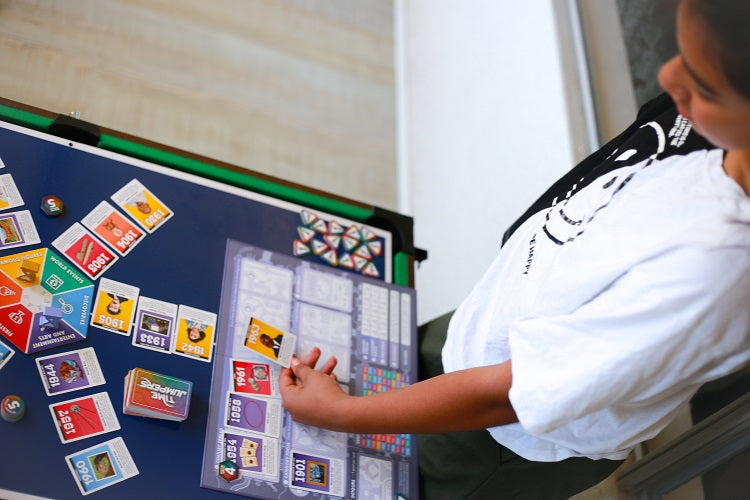
Jumping Through History with Time Jumpers
Time Jumpers featured on The Tabletop Family blogThe Tabletop Family blog, dedicated to family gameplay, shares Time Jumpers’ approach to satisfying a history + social studies-focused educational standard.
-
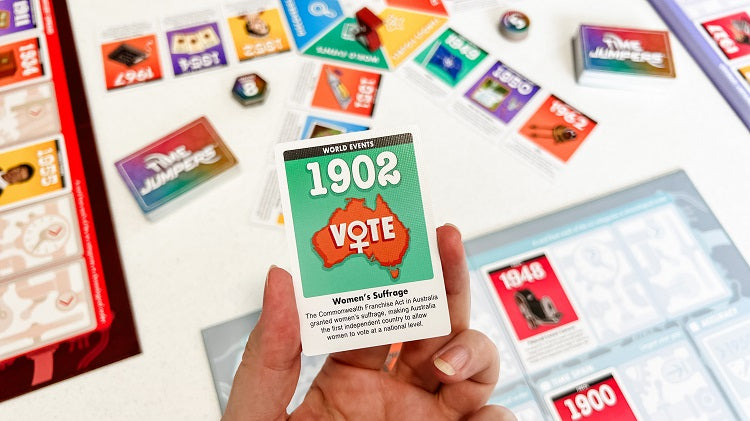
Top toys and games for lasting fun
Time Jumpers featured in The Seattle TimesTime Jumpers is featured as a top gift pick for kids for the 2023 holiday season, with a local tie to the Pacific Northwest.
-
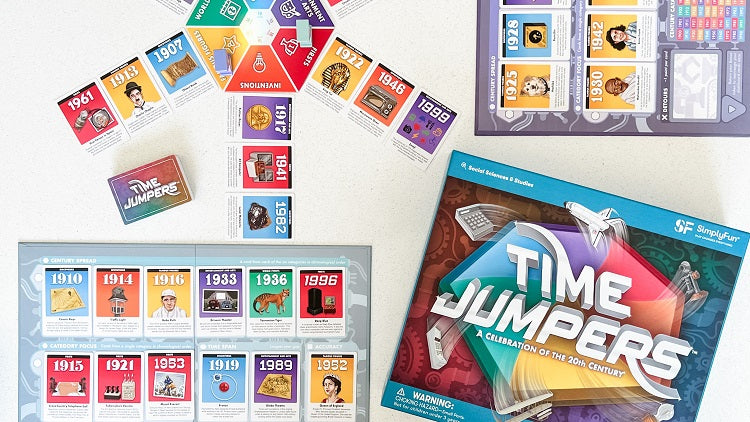
Travel Through the 20th Century in Time Jumpers!
Time Jumpers on the SimplyFun blogGet ready to travel back in time to witness some of the greatest achievements, discoveries, and events of the 20th century in SimplyFun's new Social Sciences & Studies game, Time Jumpers!
-

Time Jumpers is a Must-Have Toy
Time Jumpers featured in ParentMapParentMap says this riveting new board game takes you back in time to witness some of the greatest moments of the 20th century.
- Choosing a selection results in a full page refresh.
- Opens in a new window.



















